The housing advocate’s work is informed by her upbringing in a community in South L.A. that fought against environmental racism.

Renderings of the Adams Terrace project by Abode Communities.
Catherine Hernandez, ’13 BFA Architecture/Landscape/Interiors
I was born and raised in South Central Los Angeles in a community that has survived redlining, underdevelopment, poverty, disinvestment, policing, suppression, and environmental racism, and yet it continues to experience displacement at a higher rate than any other part of the county. A whole host of policies and practices from the mid-20th century segregated Los Angeles, sorting opportunities and resources—not just housing—along racial and economic lines.
In practice, redlining, and the lending practices that followed, denied goods and services to entire neighborhoods and swaths of cities, predominantly those inhabited by African-Americans, Latinos, and other so-called “undesirable” people. A groundbreaking report by L.A. County’s Ad Hoc Committee on Black People Experiencing Homelessness found that, in 2017, Black people represented only nine percent of the general population in Los Angeles County, yet comprised 40 percent of the population experiencing homelessness. The committee concluded that the “impact of institutional and structural racism in education, criminal justice, housing,employment, healthcare, and access to opportunities cannot be denied: Homelessnessis a by-product of racism in America.”
My mother, an active community organizer, reminded me and my sisters on the practice of collective community power through engagement and advocacy. As a practicing designer in an industry that is largely regulated by policy, I found it my responsibility to make a place for communities and the people I care about to cultivate conversations and bring the desired design into our built environment. Through a series of partnerships and workshops supporting existing nonprofits advocating for housing for all, I became invested in supporting the houseless community with resources and, eventually, in design and placemaking workshops that would lead to permanent supportive housing, transitional housing, and/or affordable housing.
About Adams Terrace: “Situated just blocks east of the intersection of Adams and Crenshaw Boulevard, within proximity to the Expo Crenshaw light rail station, Adams Terrace will offer to seniors at or below the 50 percent of the area’s median income, as well as formerly homeless/at-risk homeless seniors, 86 affordable/supportive homes with convenient access to a wide variety of community amenities. Sharp angles, clean lines, and storefront facades help inform the design of Adams Terrace, a new scattered-site, affordable housing development comprising two vacant urban infill sites in the West Adams neighborhood of Los Angeles.
Adams Terrace integrates the needs of the community in a vibrant residential community that prioritizes both form and function to deliver high-quality living and deepened community connectivity. Each residential structure is characterized by large storefront windows that provide ample light and offer seniors physical and visual connections to the street front. Additionally, balconies and large terraces with secure outdoor gathering areas extend livable space, while reducing the building’s visual mass within the neighborhood-at-large. One residential structure features a cantilevered section at the fourth floor to create a dynamic visual element that serves as a local landmark and anchors this culturally rich community. The development, hailed as a model for the future of affordable housing in Los Angeles, is expected to complete construction in Summer 2022.” —From Abode Communities
Catherine Hernandez is a Designer and Job Captain with Abode Communities, a nonprofit developer of affordable housing based in Los Angeles. She's a housing advocate and currently co-organizes with Design As Protest to hold design professionals accountable in reversing the violence and injustice that architecture, design, and urban planning practices have inflicted upon Black people and communities.



